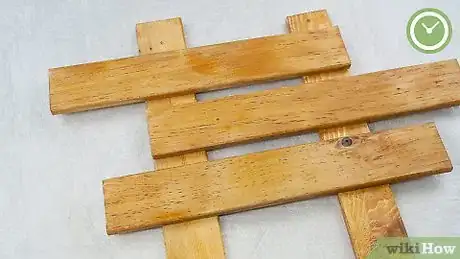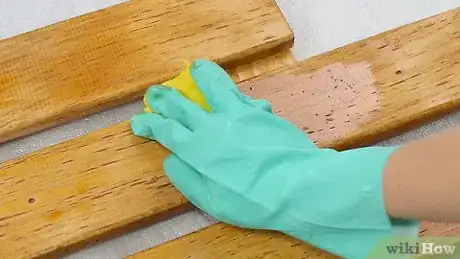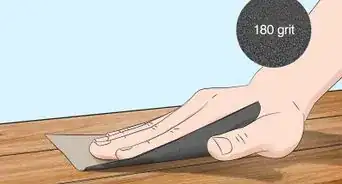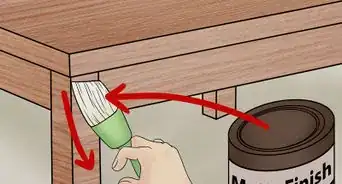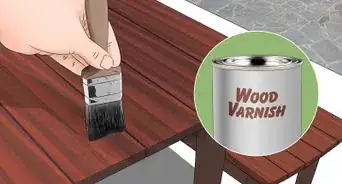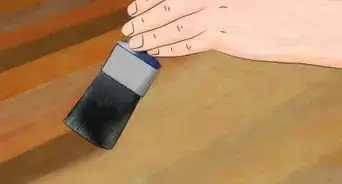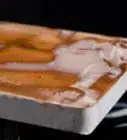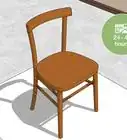This article was co-authored by wikiHow Staff. Our trained team of editors and researchers validate articles for accuracy and comprehensiveness. wikiHow's Content Management Team carefully monitors the work from our editorial staff to ensure that each article is backed by trusted research and meets our high quality standards.
There are 13 references cited in this article, which can be found at the bottom of the page.
The wikiHow Video Team also followed the article's instructions and verified that they work.
This article has been viewed 26,450 times.
Learn more...
There are many different staining products you can choose when coloring wood, but most of them take a long time to dry. Varathane is a special oil-based wood stainer created by Rust-Oleum. It can be applied to any piece of wood furniture to give it a deep, long-lasting finish. Before treating the wood, sand and clean it first. It will help the stain soak more evenly into the wood. Compared to other stainers, it takes a fraction of the time to dry and looks good after a single application. Seal the coloring in afterward for a long-lasting finish that emphasizes the natural beauty of wood furniture.
Steps
Setting up Your Workspace
-
1Take any removable parts off the wood you’re staining. Staining a piece of furniture is far easier when you’re able to do it in parts. Make sure you remove anything that could get your way as well. Arrange the furniture so it’s accessible on all sides. That way, you will be able to cover it without leaving any inconsistencies in the finish.[1]
- For example, pull out drawers and detach table legs. Broad, flat surfaces, such as tabletops, are easier to stain. Set the removed parts aside to stain separately.
- If you can’t remove a part, leave it there and work around it. You can protect most surfaces by covering them with painter’s tape if necessary.
-
2Cover the floor and other nearby surfaces with plastic. If you are able to, stain furniture outdoors to eliminate the possibility of discoloring your home’s floors. If that isn’t an option, spread a drop cloth or tarp over the floor and set the wood on top of it. Then, add protective plastic over any nearby walls or upholstery that could get dirty as well.[2]
- To deal with a cushioned chair, for instance, place a plastic sheet over the upholstery. Use painter’s tape to hold the sheet in place.
- You can get supplies online or from most hardware stores. These places also have Varathane and anything else you might need.
Advertisement -
3Put on a dust mask and rubber gloves before staining wood. Use the dust mask for protection against wood dust while you’re sanding. The rubber gloves will be necessary right away if you're removing an old finish. Otherwise, you can wait until you're ready to apply the stainer before putting them on.[3]
-
4Ventilate the room as much as you are able to. If possible, do the sanding and staining outdoors. It will help keep your home clean while also eliminating wood dust and other irritants. If you’re working inside, open up nearby doors and windows instead. Also, turn on any ventilation fans you have installed.[4]
- Keep other people and pets out of the area while you’re working.
Removing Old Finishes and Sanding
-
1Apply a leave-on paint stripper to the wood if it has an old finish on it. Select a paint stripper that you don’t have to rinse off afterward. Also, choose a product that matches the type of finish on the wood you’re staining. Then, apply it with a disposable paint brush. Make sure the entire surface is well-covered.[5]
- For example, your finish could be varnish, lacquer, or something else. Each one requires a specific product. Get a varnish remover if you have a varnish finish, for instance.
- If you’re unsure what kind of finish you’re dealing with, apply a few drops of a solvent like denatured alcohol, which softens shellac. Lacquer thinner works on lacquer, while xylene works on water-based finishes.[6]
-
2Wait about 20 minutes for the stripper to activate. It will soak into the finish and soften it. If you’re removing paint, you may see the paint bubble and crack. For other types of finishes, watch for the finish to turn cloudy or otherwise become soft and sticky.[7]
- Note that you may need to let the product soak in for longer in order to fully soften the finish. Check the manufacturer’s instructions to determine the recommended wait.
-
3Remove the old finish with a paint scraper. Gently scrape the old finish from one end of the wood to the other. Press down with a light amount of pressure to avoid scratching the wood. The softened finish will peel off without difficulty. Make sure it is completely removed.[8]
- You could also use fine steel wool to remove stubborn residue. Be careful and scrub only along the wood’s grain to avoid scratches.
-
4Sand the wood lightly along its grain with 120-grit sandpaper. If you look closely at the wood, you will be able to see some small, dark lines running from one end to the other. The grain is the pattern of the fibers inside the wood, and following them is very important. Starting at one end of the wood, begin scrubbing with circular motions along the grain. When you reach the end, go back to start on an untreated portion of the wood, repeating until the entire piece has been sanded evenly.[9]
- Going across the grain is a sure way to cause scratches that show up through the finish. They can often be removed by sanding the wood along its grain.
- The sandpaper is somewhat rough, so don’t scrub too hard. It could scratch the wood if you’re not careful.
-
5Rub the wood a second time with 150-grit sandpaper. Sanding wood multiple times leads to a much smoother finish that absorbs plenty of Varathane stain. Always use a sandpaper grit a little higher than the one before it. Take your time to sand the entire piece of wood on all sides, making sure you don’t miss any spots.[10]
- If you’re planning on only sanding the wood once, use 150-grit sandpaper. It is perfect for opening the wood’s pores without leaving the surface too rough.
-
6Smooth the wood by sanding it with 180-grit sandpaper. Both types of sandpaper are considered very fine, so they are useful for wearing down any rough spots left on the wood. Rub it gently along the grain to make it consistent. Touch the wood afterward and, if you notice any spots that still feel rough, be sure to wear them down before staining.[11]
- Any rough patches, swirls, or sanding marks could prevent the Varathane from soaking in evenly. Make sure you sand every area with the same, consistent amount of pressure.
- Always finish with the highest grit you have available. Using a lower grit will affect the stain and leave visible scratches.
-
7Clean wood dust and other debris off with a tack cloth. Any debris left on the table could ruin the finish, so give the wood a thorough wipedown a couple of times to make sure you eliminate all of it. Look for any spots you missed that may require a little more attention. Once the entire surface looks smooth and consistent, it can be stained.[12]
- You could also use a shop vacuum to suck up all the dust from the table. Most regular vacuums won’t work, but shop vacuums are able to trap even fine dust particles.
- If you don’t have a tack cloth or vacuum, dampen a lint-free cloth in a little bit of lukewarm water and wipe down the wood. Dry off the moisture with a second cloth.
Staining the Wood
-
1Stir the Varathane thoroughly before applying it to the wood. Open the canister of Varathane and set it near your table. Varathane has a sediment in it that has to be mixed in so it doesn’t settle at the bottom. Use a wood stirring stick to swirl it around for 15 to 30 seconds. Make sure the Varathane is a uniform color with no solid sediment floating in it.[13]
- The sediment is responsible for the stain’s coloring. If it isn’t well-mixed, it could cause the stain to appear uneven later.
-
2Load the Varathane onto a foam brush. Try using a 2 in (5.1 cm) foam brush for a consistent, controlled application. Dip the brush into the container to scoop out a small amount of the Varathane. Get as much as you will need to apply a thin but consistent coating to the wood. Make sure it isn’t dripping when you move toward the wood.[14]
- You could also apply the stainer with a synthetic-bristle paint brush or a clean, lint-free cloth. Many experienced woodworkers find using a cloth to be easier and claim that it leads to a better finish.
-
3Drag the brush along the wood’s grain to apply the stainer. Start at one end of the wood and follow the grain toward the opposite end. Apply the Varathane in a strip along one part of the wood. When you reach one end, start again at the beginning. Take time to smooth out the stain to ensure that the finish is consistent.[15]
- Go back over treated sections once or twice, especially if you notice excess stainer pooling anywhere. Spread out the excess before applying additional product.
- If you notice puddles forming, apply less of the Varathane. Keep the coating thin to avoid making the finish too dark.
-
4Treat 2.15 sq ft (0.200 m2) sections at a time to prevent the stain from drying out. Since Varathane dries pretty quickly compared to other products, you’re better off applying it in limited amounts. Cover small areas with each application. Make sure each part is saturated with a consistent coating of the stain before moving on to the next one.[16]
- To get a consistent finish, let the Varathane sit for a couple of minutes, then wipe up the excess before beginning on the next section.
- You may not be able to finish a project in a single coat. With a tabletop, for instance, let the top dry completely, then flip it over to finish the underside.
-
5Wait 2 to 3 minutes for the stain to settle into the wood. If you’re thinking that a couple of minutes seems like too short of a time for the stain to dry, you’re right. The Varathane will settle into the wood during this time, but it won’t begin drying. This will give you a chance to check the finish one last time before allowing it to dry.[17]
- Expect Varathane to begin drying after 5 minutes. Make any adjustments to the finish before then. Don’t wait too long!
-
6Scrub off any excess Varathane with a cloth before it dries. Go back over the coated portion of the wood with a clean cloth. Press the cloth down lightly while rubbing it along the grain. It will absorb any excess still on the wood so that the finish is more uniform. Spots with excess Varathane will turn darker than the rest of the wood, so be aware of any areas that look wet or inconsistent.[18]
- You don’t have to remove the stainer, but it’s worth doing to ensure that the final coloring isn’t overly dark or spotty. If you think that the coating looks even and is the color you want, you can leave it alone.
- If you’re concerned about the stain looking too dark, you are better off removing as much of it as you can now. You can always follow up with another coating if you need to darken it later.
Finishing and Sealing the Stain
-
1Wait about 1 hour for the stain to dry. Leave the wood out in an open area with good air circulation so it dries out at a faster rate. Let everyone else in your home know not to touch it. Note that the drying time may vary a little bit depending on the weather. It dries out fastest during warm days with low humidity.[19]
- Other staining products take up to a day to dry. The main advantage of Varathane is that it’s so much quicker, so you can get to finishing the project right away.
-
2Apply Varathane to any surfaces you were unable to reach originally. Sometimes you aren’t able to finish a piece as a consistent whole. Once the wood is dry to the touch, you can flip it over and begin addressing any sides you missed earlier. Coat these sides by spreading the Varathane in a thin layer along the grain. Remember to tackle small sections at a time so the Varathane doesn’t dry out before you are able to clean up any excess.[20]
- These surfaces will all need time to dry, too. Let them dry for an hour or else the finish will get ruined when you flip the wood back over.
- You might need to do this with a tabletop, for example. If you detached it from its legs and laid it on top of a drop cloth, you wouldn’t be able to reach its underside without flipping it.
-
3Recoat the wood with additional layers of Varathane to darken the finish. One coating of Varathane is often enough to give wood a new, bright finish. Take a step back and examine the wood from a few different angles. If it looks too light or inconsistent, it could benefit from another coating. Spread more Varathane in small sections along the grain with a brush or rag.[21]
- Most projects will look great after a single coating, or with 2 at most. Apply the stainer sparingly, since each layer darkens the finish.
- Remember to let each application dry for an hour. Also, flip the wood to recoat any surfaces you couldn’t reach. Make sure they all receive the same amount of Varathane.
-
4Finish the wood with a clear top coat to protect it from damage. After the new stain has finished drying, seal it in. Polyurethane and lacquer are both water-resistant and good for finishing unsealed wood surfaces. Stir the clear coat in its container, then spread it along the wood’s grain with a fresh brush or rag. Drag your brush along the grain again afterward to smooth out the coating and fill in any gaps.[22]
- For the best result, apply 2 to 3 thin layers of clear coat. It will result in a smooth, shiny finish that lets the wood’s new stain shine.
- To help clear coat layers adhere to one another, you could scrub them gently with a piece of 320-grit sandpaper.
-
5Let the clear coat dry for at least 24 hours. It’s more waiting, but you’re almost done. Leave the wood alone in a dry spot with plenty of air circulation. The exact drying time will vary depending on the weather. Make sure no one else touches the wood in the meantime. Once the wood is dry to the touch, you can proudly display the wood to enjoy its fresh finish.[23]
- Remember to flip the wood over if you need to in order to cover sides you couldn't finish earlier. Give the fresh layer of clear coat another day to dry.
Warnings
- To avoid breathing in anything dangerous, wear a dust mask when sanding or staining wood. Also, put on rubber gloves while handling Varathane to avoid discoloring your skin.⧼thumbs_response⧽
Things You’ll Need
- Varathane wood stain
- Clear coat wood sealer
- Foam brush or synthetic paint brush
- Lint-free cloths
- Tack cloth or vacuum
- 120-grit sandpaper
- 150-grit sandpaper
- 180-grit sandpaper
- Dust mask
- Rubber gloves
- Paint stripper (optional)
References
- ↑ https://www.bobvila.com/articles/44273-how-to-stain-wood-furniture/
- ↑ https://www.bobvila.com/articles/44273-how-to-stain-wood-furniture/
- ↑ https://www.bobvila.com/articles/44273-how-to-stain-wood-furniture/
- ↑ https://www.bobvila.com/articles/44273-how-to-stain-wood-furniture/
- ↑ https://www.bobvila.com/articles/how-to-remove-varnish/
- ↑ https://www.woodmagazine.com/materials-guide/finishes/what-finish-is-that-anyway
- ↑ https://www.bobvila.com/articles/how-to-remove-paint-from-wood/
- ↑ https://www.bobvila.com/articles/44273-how-to-stain-wood-furniture/
- ↑ https://www.popularmechanics.com/home/interior-projects/how-to/a26873/wood-finishing-oil-stain/
- ↑ https://www.thisoldhouse.com/how-to/how-to-stain-and-finish-wood-furniture
- ↑ https://www.popularmechanics.com/home/interior-projects/how-to/a26873/wood-finishing-oil-stain/
- ↑ https://www.thisoldhouse.com/how-to/how-to-stain-and-finish-wood-furniture
- ↑ https://www.rustoleum.com/pages/homeowner/tips-and-techniques/wood-staining/Applying%20wood%20stain/
- ↑ https://www.thisoldhouse.com/how-to/how-to-finish-wood-table
- ↑ https://www.thisoldhouse.com/how-to/how-to-finish-wood-table
- ↑ https://www.youtube.com/watch?v=NFT9e_6Dzh8&feature=youtu.be&t=85
- ↑ https://www.youtube.com/watch?v=NFT9e_6Dzh8&feature=youtu.be&t=90
- ↑ https://www.thisoldhouse.com/how-to/how-to-finish-wood-table
- ↑ https://www.youtube.com/watch?v=NFT9e_6Dzh8&feature=youtu.be&t=108
- ↑ https://www.popularmechanics.com/home/interior-projects/how-to/a26873/wood-finishing-oil-stain/
- ↑ https://www.bobvila.com/articles/44273-how-to-stain-wood-furniture/
- ↑ https://www.bobvila.com/articles/2150-paints-and-finishes/
- ↑ https://www.bobvila.com/articles/how-to-waterproof-wood/
- ↑ https://www.bobvila.com/articles/44273-how-to-stain-wood-furniture/
- ↑ https://www.bobvila.com/articles/44273-how-to-stain-wood-furniture/






